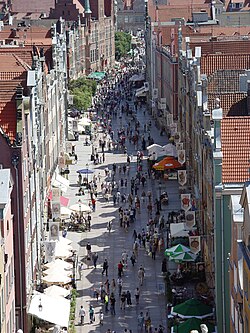About Gdańsk
Poland lies in the heart of Europe, on the eastern edge of the European Union. It is thus ideally suited to attract participants from across the whole of Europe and indeed the world.
       |
Gdańsk on Wikipedia: af an ar be-x-old bs br bg ca cs co cu cv cy da de dsb et el es eo eu fi fo fr fur gv gl ko he hsb hr io id ia is it ja jv csb ht la lv lb lt hu mk mt na nl nap no nn oc nds pl pt ro qu ru se sc scn sq simple sk sl sr szl sv tr uk vo yi zh

The millennium-old Gdańsk is the sixth largest Polish city, forming a conurbation with the spa town of Sopot, the city of Gdynia and suburban communities, which together form a metropolitan area called the Tricity (Trójmiasto), with a population of over 800,000. Gdańsk itself has a population of 458,053 (2006). It is the richest historic site among the Baltic cities. Most of the attractions are several centuries old (although it should be noted that many did not survive World War II intact and were rebuilt afterwards). These are located along the Droga Królewska (The Royal Tract), in the Main Town and the Promenade.
Restored houses, whose original designs date back to the 16th and 17th century and which used to belong to the patricians, imbue the city with a specific spirit. Among these is the Uphagen House, where a department of the Historical Museum of Gdańsk is located, as well as the Gothic-style Old Town Hall.
The Długi Targ (Long Market) - in the 13th century a merchants' route - is the home of the Fountain of Neptune, the city's symbol, as well as Dwór Artusa (Arthus' Court), Złota Kamienica (Golden House) and Nowy Dom Ławy, where daily at 13:03 (as well as at 15:03 and 17:03 in the high season) one can see a 17th-century damsel peering out of one of the windows!
The island of Ołowianka hosts the building of the Baltic Philharmonic Theatre as well as the Central Maritime Museum of Gdańsk - the proposed venues for the conference, located in buildings adapted from 19th-century power and heating plants and visible from the Old Town's promenade.
One of the most frequently visited streets of the city's Old Town is Piwna Street, with its numerous cafés and clubs. There is also a nearby Ewan Cabaret - a local counterpart of the Parisian Moulin Rouge.
The city is also the home of the Teatr Wybrzeże, which - together with the National Theatre in Warsaw and Teatr Stary in Kraków - forms the core of the Polish theatre world. Nearby, on the Targ Drzewny (Wood Market), one can find the statue of Jan III Sobieski, and Korzenna Street houses the Old City Hall, where richly-ornamented chambers as well as the old Mayor's office can be visited. An Irish pub is located in the Hall's basement.
Another place worth mentioning is the Gdańsk Shipyard, where the fight against real socialism had one of its major chapters written. The square in front of the Shipyard is the place of the Monument to the Fallen Shipyard Workers commemorating the first three shipbuilders who died in December 1970. In August 1980 the shipyard was the birthplace of the Solidarność labour union and freedom movement (please note that 2010 will witness Solidarity's 30th anniversary - the celebration of freedom in the political sense, which might additionally be accentuated by the celebration of free culture in the very same city), which will be commemorated by the Europejskie Centrum Solidarności (European Solidarity Centre), planned to be built by 2013 and forming a complex of museum and conference facilities. Currently the exhibits for the Centre can be viewed in the underground rooms of the National Board of "Solidarność" Labour Union, located in Wały Piastowskie Street.
Among other tourist sites there are Westerplatte, where the Second World War began, and the Cathedral in Oliwa, where baroque organ concerts are played.
Gdańsk is also a popular tourist destination because of its numerous beaches, piers, cultural events and coastal attractions, which attract young and old alike.
TriCity is a seat of learning, being home to Gdańsk University, Technical University, Medical University, Music Academy, Academy of Fine Arts, Maritime Academy, Academy of Physical Education and Sport and many other high schools. Gdańsk Technical University also boasts , the country's most powerful computing cluster, built with the use of 1344 quad-core Xeon CPUs.
The city's potential for hosting large events was confirmed and will be put to another test this year, when the 20th anniversary of the major political changes in the region will be combined with the 70th anniversary of the start of WW2, which - according to the Polish government - may happen in Gdańsk.